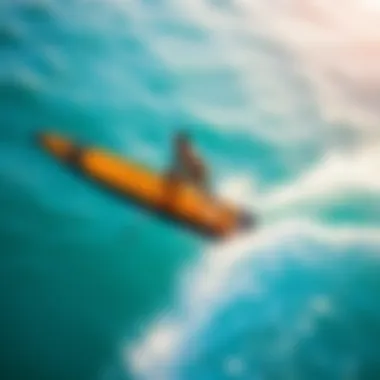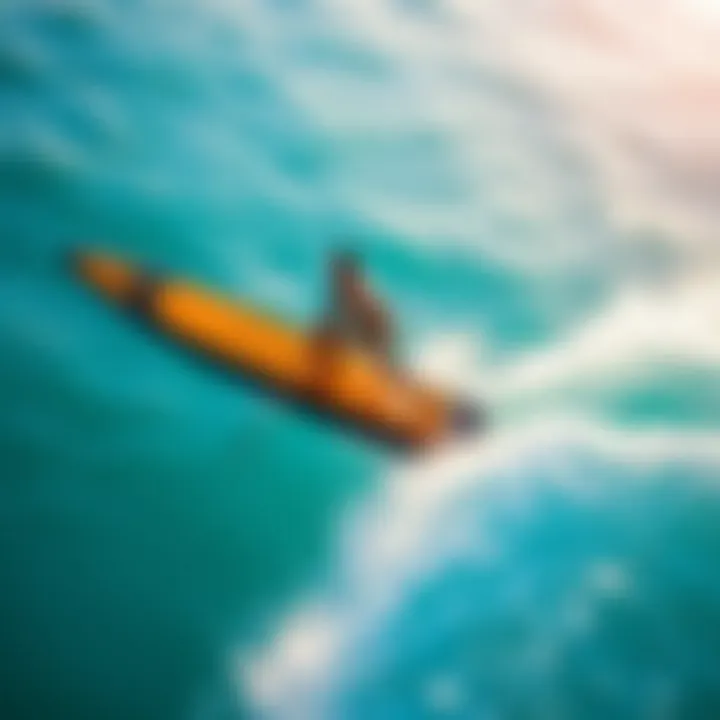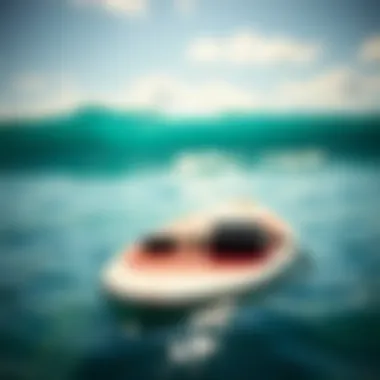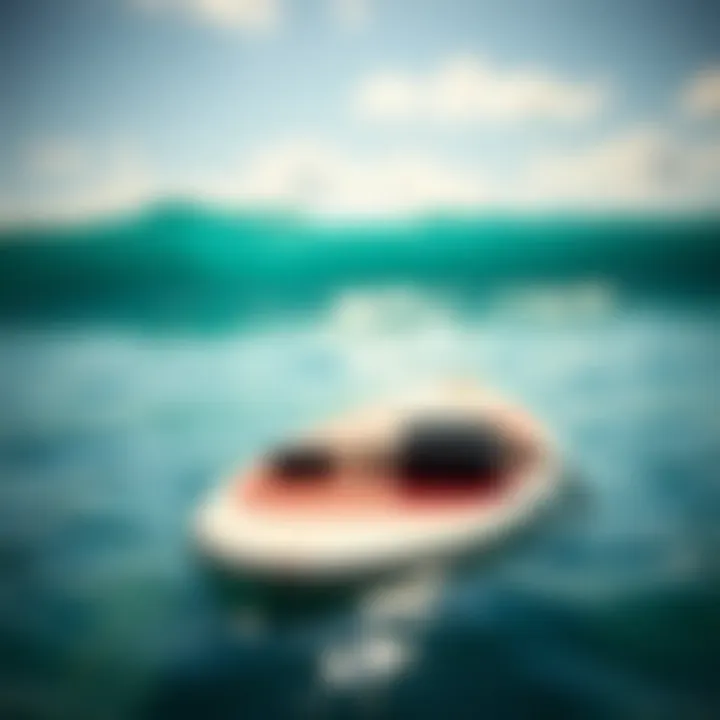Comprehensive Guide to Wing Surfboards: Features and Techniques


Intro
Wing surfboarding is capturing the hearts of thrill-seekers and water sports fans alike. As the sport grows, understanding wing surfboards goes beyond just having fun on the water; it's about mastering the craft and engaging with a community that shares your passion. From the wind in your face to the crisp, refreshing waves, there's something about riding a wing surfboard that connects you deeply with nature.
In this guide, we’ll embark on an exploration of the intricate world of wing surfboards. This will cover essential aspects like gear selection and skill development, ensuring you have all the tools you need for an enjoyable experience. Let's dive deeper into what makes a good wing surfboard and the techniques that will elevate your performance.
Gear Selection
Types of Kites
Choosing the right kite is essential in wing surfing. Kites come in various shapes, sizes, and designs, each suited to specific wind conditions and rider preferences. You might encounter the following types:
- Foil Kites: These are popular due to their efficiency and smooth power transitions. They perform well in light winds, making them ideal for experienced surfers.
- LEI Kites (Leading Edge Inflatable): These kites are more stable and often easier for beginners. Their ability to withstand stronger winds makes them a solid choice for new riders.
When selecting a kite, consider the wind conditions in your area and your skill level. An inexperienced rider might want to stick with an LEI kite while advanced users might prefer the enhanced performance of a foil kite.
Choosing the Right Board
The board is another crucial piece of equipment. When selecting a wing surfboard, several factors come into play, including size, shape, and construction.
- Size: The size of the board should match your body weight and skill level. Heavier riders or beginners may benefit from a larger board that offers greater stability. Conversely, more experienced riders often prefer a smaller, more maneuverable board.
- Shape: Boards come in different shapes, such as wide and flat for stability, or narrow for speed and agility. Think about what type of riding you enjoy—crossing waves might call for a different shape than gliding smoothly over flat water.
- Construction Material: Lightweight materials can help with maneuverability, while durable options ensure longevity in rough conditions.
Ultimately, selecting the right kite and board significantly impacts your performance and enjoyment on the water. When in doubt, consulting other riders or instructors can provide additional insights tailored to your needs.
"The right gear can change your entire experience; invest wisely."
Ending
The choice of gear forms the foundation of your wing surfboarding adventures. With the right kite and board, you can harness the wind's power, ride the waves, and elevate your kiteboarding experience to another level. As we proceed through the guide, next, we'll delve into skill development, covering essential techniques and helpful tips to progress in wing surfboarding.
Preface to Wing Surfboarding
Wing surfboarding is rapidly gaining traction within the kiteboarding community, blending aspects of both surfing and traditional wind sports. Understanding this evolution is not just a matter of riding the waves; it's about recognizing the unique vibe and energy that wing surfboards bring to the water. Emphasizing the sport's adaptability, wing surfboards allow riders of various skill levels to enjoy the thrill of gliding across water while using the wind as propulsion.
Defining Wing Surfboards
Wing surfboards are specialized boards designed for harnessing wind power via a handheld wing. Unlike standard surfboards or kiteboards, these boards feature a broader construction and a shape optimized for stability and maneuverability on the water. The beauty of wing surfboards is in their versatility; they can be used in a variety of conditions, from flatwater to wave riding. Their smaller size compared to traditional kites allows for a more intimate experience with the water, offering a different rhythm and flow.
Some important features that define wing surfboards include:
- Shape: The outline often resembles aspects of both surfboards and foil boards, sometimes incorporating a slight rocker to assist with navigation in varying waters.
- Volume: Adequate volume ensures buoyancy, allowing riders to maintain stability while navigating challenging conditions.
- Fins: Wing surfboards often come fitted with a range of fin setups that enhance stability and control during fast maneuvers.
Evolution of Wing Surfboards
The evolution of wing surfboards has been a fascinating journey, echoing advancements in wind sports and watercraft design. Initially developed as an alternative to traditional windsurfing, this sport has rapidly evolved over the last few years. The need for portability, ease of use, and adaptability was the driving force behind this evolution.
Riders sought a way to experience the wind without the limitations of a large sail. This prompted innovations in wing design, leading to lighter materials, streamlined shapes, and improved handling capabilities. Early designs have paved the way for more sophisticated models that cater to a wide range of skill levels and water conditions.
In summary, understanding the core components of wing surfboards not only enhances your riding experience but also fosters a deeper appreciation for the sport's innovation and community. These boards are truly a testament to the creativity and passion found within the kiteboarding family.
Understanding the Design
Understanding the design of wing surfboards is crucial for anyone looking to master this exciting sport. The design influences not only performance but also the ease of use and enjoyment while riding. Each element of a wing surfboard, from the materials used in construction to its dimensions, plays a role in how it responds in various conditions
Construction Materials
The materials used in the construction of wing surfboards are vital to their performance and durability. Common materials include polyurethane foam, fiberglass, and carbon fiber. Each has its distinct advantages.
- Polyurethane Foam: This material is quite light and buoyant, offering a good stiffness-to-weight ratio. It's often favored by beginners due to its cost-effectiveness and reasonable durability.
- Fiberglass: Many boards are reinforced with fiberglass layers. This addition enhances strength without overly increasing weight. Its flexibility allows for a bit of give, which can be beneficial in choppy waters.
- Carbon Fiber: In contrast, carbon fiber is lauded for its exceptional strength and lightness. While it's usually pricier, riders who prioritize performance often find it a worthy investment. The responsiveness of carbon fiber boards is remarkable, making them a top choice for more experienced riders.
Size and Shape Considerations


When choosing a wing surfboard, the size and shape are pivotal factors that dictate how the board will perform in the water.
Volume
Volume refers to the board's buoyancy and impacts its buoyancy and stability.
- The more volume a board has, the more buoyant it is. This aspect is crucial for beginners, as it helps keep the board afloat even in less-than-ideal conditions.
- A board with high volume is easier to learn on, providing a stable platform to find one’s balance. Riders often gravitate toward boards with larger volumes when starting out.
- However, it's essential to note that while high volume can be beneficial, at some point, too much can hinder performance, especially for advanced maneuvers.
Length
Length plays a crucial role in speed and maneuverability.
- Longer boards generally excel at straight-line speed, which is perfect for catching waves or gliding over long distances. This characteristic can make a difference for those who prefer to ride swiftly.
- Conversely, shorter boards are often more responsive and allow for quicker turns and tricks, albeit at lower speeds. A rider might prefer a shorter board for dynamic conditions or technical riding.
- Determining the ideal length can depend on personal riding style and specific water conditions.
Width
Width affects stability and paddling efficiency.
- Wider boards are typically more stable, making them a solid choice for beginners or for those who want to ride in choppy waters. The added width can help prevent flipping and facilitate easier balance.
- On the flip side, narrower boards can cut through the water more effectively, allowing for better speed and performance, especially for advanced riders looking for agility.
- Picking the right width depends on the intended use as well as the skill level of the rider.
All these design elements, from volume and length to width, contribute significantly to a rider’s experience on the water. It is crucial to match one’s board selection with personal preferences and riding goals.
Selecting the Right Wing Surfboard
When it comes to wing surfboarding, selecting the right board isn't just a matter of preference; it can directly affect performance, comfort, and fun out in the water. Choosing a wing surfboard that aligns with your specific skill level, riding style, and typical conditions is crucial. If you pick a board that doesn’t match your capabilities, you could end up with a frustrating experience that might even demotivate you from pursuing the sport further. So, let’s dive into key elements and considerations that will assist you in finding the perfect fit.
Skill Level Matching
Matching your skill level with the right wing surfboard is paramount. If you’re just starting out, a board with more volume and stability is favorable. These boards make it easier to maintain balance and handle the wing while you’re learning the ropes. As you progress, you might want a more responsive board that allows for quicker turns and advanced maneuvers. A simple way to determine the right board is to consider the following:
- Beginner: Look for boards with higher volume to aid buoyancy and stability.
- Intermediate: A medium volume board that balances stability and performance works well.
- Advanced: Opt for lower volume boards that enhance agility and speed, allowing for intricate tricks and turns.
It's not all about technical specifications, though. Sometimes, it's about how a board makes you feel. A board that feels right under your feet significantly boosts your confidence, which is a key ingredient in mastering the craft.
Weather and Water Conditions
Understanding the type of weather and water conditions you'll be riding in plays a big role in selecting the right board. Conditions vary from flat, calm waters to choppy seas, and each scenario demands a different approach. Here’s a breakdown:
- Flat Water: If you're usually spotted shredding on smooth surfaces, consider a board that offers greater speed and control. These boards tend to be longer and narrower, allowing you to pick up speed without as much drag.
- Choppy Waters: If you find yourself in rougher conditions, stability becomes essential. Choose a wider board which provides enhanced buoyancy and helps you maintain control while navigating through waves.
- Waves: For surf conditions, a shorter, more maneuverable board is ideal. You’ll want to catch and ride swells easily, which requires a design optimized for quick turns.
"Selecting the right equipment according to environmental factors allows you to maximize your performance and enjoyment on the water."
Techniques for Mastering Wing Surfboarding
Mastering wing surfboarding requires more than just hopping on a board and catching some wind. It’s an intricate dance between rider, board, and the elements, where understanding and skill can elevate the experience dramatically. The techniques you adopt can be particularly significant in enhancing efficiency, improving safety, and ultimately making the journey more enjoyable. In this section, we will dissect the essential techniques, beginning with the fundamentals of launching and landing, continuing through precise board control, and culminating in advanced riding techniques that can astound and impress.
Launching and Landing Basics
Launching and landing can feel like the most daunting aspects of wing surfboarding, but they lay the foundation for every session. Proper execution of these basics ensures not only your safety but also sets the tone for the entire ride. When launching, finding the right balance between wing positioning and wind angle is crucial. You want to ensure the wing catches enough wind without pulling you off balance. Start with the wing slightly in front of you and then gently lift it as the wind catches it. Remember to keep your feet planted, ready to step onto the board as the wind picks up.
When it comes to landing, it’s all about making a smooth transition. Gradually decrease the power in the wing by tilting it back while you guide your board towards the shore. Using your body weight to modulate power can help control your descent and make the landing less jarring. Practice makes perfect—each session will refine your ability and boost your confidence.
Board Control and Maneuvering
Board control is the very heartbeat of wing surfboarding. It’s what enables a rider to respond dynamically to changing wind conditions and water surfaces. Here, a few techniques can significantly enhance one’s agility and precision. Firstly, mastering foot placements on the board creates a balance that allows for quicker adjustments. Keep your knees slightly bent and stay low, enabling you to absorb the energy of the waves or chop efficiently.
Additionally, body positioning plays a vital role. Shifting your weight forward or backward alters the board's response to the wind. Want to accelerate? Lean forward and point the board in the direction you want to go. Need to slow down? Shift your weight back. The incredible thing about wing surfboarding is that every small movement has a direct impact on your performance. Even getting a slight shift in your shoulders can make the difference between a perfect turn and a tumble.
Advanced Riding Techniques
Jumps and Tricks
Jumping and performing tricks is sometimes seen as the zenith of wing surfboarding. It combines skill, timing, and creativity, offering riders a way to express themselves on the water. One key characteristic of jumps is the way they challenge a rider’s control and understanding of wind dynamics. When executed correctly, jumps not only look stunning; they can give a buoyant sense of freedom that is hard to match.


To initiate a jump, it’s about timing with the wave—loading up just before the board hits the lip of the swell while simultaneously pulling the wing in. This increases lift and propels the rider upwards. The thrill of performing tricks comes not just from the jump itself but from the ability to tailor those jumps into various tricks, be it rotations or flips.
The benefits of mastering jumps can be multifaceted. It boosts confidence and showcases skills, setting a rider apart. However, the complexities involved mean that beginners should approach jumping with caution, ensuring they’re comfortable with the basics before taking flight.
Crosswind Riding
Crosswind riding is as exhilarating as it is challenging. Riding across the wind rather than directly into it can open up a whole new world of speed and maneuverability. A key trait of crosswind riding is its potential to maximize the wing's power while minimizing drag. This can be especially beneficial when paired with an understanding of the water's shape and conditions, allowing for seamless transitions and thrilling rides.
To engage in effective crosswind riding, one must maintain an optimal angle to the wind. This includes adjusting the wing and body position. Learning to read the wind's shifts and gusts will help exploit these conditions better. While fast and liberating, it requires a sense of awareness, as changes in wind can affect control. Regular practice can mitigate these risks and enable you to take advantage of glorious conditions whenever they present themselves.
"Embracing the nuances of wing surfboarding techniques enriches your experience and transforms challenges into thrilling exploits."
Understanding and refining these techniques is vital in enhancing your wing surfboarding experience. By committing to learning about launching, board control, and advanced techniques, riders develop a nuanced understanding that allows them to navigate the water with both skill and ease.
Maintenance and Care for Wing Surfboards
Taking care of your wing surfboard isn’t just about keeping it looking spick and span; it's about prolonging its life and ensuring optimal performance out there on the water. Regular maintenance can prevent minor issues from turning into major headaches, and it keeps the board performing at its peak, no matter the conditions. This section dives into key practices that any dedicated kiteboarder should engage in to keep their gear in top-notch condition.
Regular Inspection Protocols
A wise sailor checks his sails before the voyage, and for wing surfboard enthusiasts, this means regular inspections. Here’s how to effectively keep tabs on your board’s health:
- Visual Inspections: Give your board a once-over before and after each session. Look for any visible damages like scratches or dents. If you spot any repairs needed, don't procrastinate.
- Check for Leaks: If your board has inflatable components, it’s crucial to check for leaks. You can do this by inflating the board and listening for any hissing sounds or using soapy water to spot bubbles.
- Hardware Inspection: Regularly inspect the screws and components. Ensure everything is securely fastened to prevent mishaps during a ride.
By incorporating these simple checks into your routine, you can extend the lifespan of your board and avoid unnecessary costs down the line.
Storage Solutions
Where you store your wing surfboard can make a world of difference. When not in use, proper storage helps fend off the effects of wear and tear from environmental elements. Here are a few storage strategies:
- Dry and Cool Locations: Avoid leaving your board in direct sunlight for extended periods. Prolonged sun exposure can degrade materials over time. Instead, consider a shaded garage or a cool room.
- Upright Positioning: Whenever possible, store your board upright. This method reduces the chances of warping and keeps it from collecting dust and grime.
- Use a Board Bag: Protecting your board with a padded bag when transporting it or during storage can help guard against unnecessary bumps and scratches.
These simple practices save you stress and money while ensuring that your board remains ready for your next adventure on the waves.
Keeping your gear in great shape doesn’t just benefit you; it also reflects respect for the sport and the environment.
For more insights on the best practices in storage and maintenance, check resources like Kiteboarding or visit forums like Reddit. Applying these principles will assure you get the best out of your wing surfboard, keeping the thrill alive every time you hit the water.
Environmental Considerations
As the popularity of wing surfboarding continues to swell, understanding its environmental impact becomes crucial. This segment focuses on essential elements such as sustainable practices and local ecosystem awareness that every kiteboarder should integrate into their experience. By doing so, we not only enhance our sport but also contribute positively to the natural landscapes we enjoy.
Sustainable Practices in Kiteboarding
Sustainability in kiteboarding often extends beyond just the gear we choose; it encompasses our entire approach to the sport. Here are a few practical strategies:
- Opt for Eco-Friendly Boards: Choose wing surfboards made from sustainable materials or those that prioritize low environmental impact in their manufacturing processes. Brands like Naish and DUOTONE are increasingly incorporating recycled materials into their designs.
- Minimize Waste: By maintaining gear properly, we can extend its life. This older gear often finds its way into landfills if not taken care of. When something breaks, consider repairs before replacement.
- Support Local Businesses: When purchasing equipment or gear, support local retailers who share a commitment to sustainability.
Each of these steps contributes to a greater understanding of our footprint on the environment while participating in this exhilarating sport. As you ride those waves, remember that your choices can lead to a healthier ocean.
Local Ecosystem Awareness
Being mindful of the unique ecosystems where you wing surf is essential. Consider these points for protecting marine and coastal environments:
- Education on Local Species: Learn about the fragile ecosystems where you surf. For instance, some areas may host nesting sea turtles or sensitive coral reefs, which can be easily disturbed.
- Protect Wildlife: Always maintain a respectful distance from wildlife. Approach nesting areas with care and ensure that your activities do not disrupt their habitats.
- Follow Regulations: Each surf spot has its own set of environmental laws and guidelines. Stay informed through local government resources such as *.gov sites to understand the rules tied to wildlife and coastal management.
"Being a responsible kiteboarder means recognizing that we are not just participants in this sport; we are stewards of nature."
Comparative Analysis: Wing Surfboards vs. Other Boards
When it comes to the world of water sports, the bustling options can sometimes leave enthusiasts a bit perplexed. Wing surfboards, kiteboards, surfboards, and stand-up paddleboards (SUPs) each hold their own charm and functionality. In this comparison, we will dissect what sets wing surfboards apart from other boards, outlining the benefits and important considerations that come into play for riders of various backgrounds.


Kiteboards and Wingboards
At first glance, wingboards and kiteboards might seem like two peas in a pod, especially when used against the winds and waters that thrill kiteboarding enthusiasts. However, their key differences lie in technique and usability.
- Control: Wingboards offer users enhanced control in light winds. The wing acts like a sail, giving a more direct feedback loop to the rider. In contrast, kiteboards often require more input and management, aligning the user more closely with the kite’s behavioral dynamics.
- Learning Curve: For beginners, wingboards may present a gentler learning curve. The immediate and intuitive connection between the board and wing often leads to quicker rounding the learning bend. For instance, while kiteboarding spreads its focus over multiple elements—wind direction, kite control, and board handling—wingboarding simplify things a notch.
- Transportability: Wingboards have distinct advantages when it comes to transport. Their lightweight build and ease of inflation allow for easier packing. Kiteboards, bearing the logistics of kites and lines, can feel cumbersome, especially for those on the go.
A notable takeaway from this comparison is the way different conditions dictate the board’s efficacy. While some advanced kiteboarders may swear by their setup for strong winds, novice riders may find themselves more comfortable venturing with a wing at their side. In regions with variable winds, wingboards can shine more brightly.
Surfboards and SUPs
Now, drawing a line toward traditional surfboards and stand-up paddleboards, the contrasting elements come into clearer focus:
- Wave Interaction: Surfboards are built explicitly for riding waves, focusing heavily on maneuverability and responsiveness in dynamic ocean conditions. Wing surfboards bridge the gap, allowing riders not just to catch waves but also to harness wind, providing more flexibility during sessions. This means a wing surfer can navigate through waves and also glide through flat conditions where traditional surfing may falter.
- Versatility: When it comes to versatility, wingboards deliver a unique twist. They can be used in myriad conditions—from flat water to powerful seaside surf. Surfboards and SUPs, particularly geared towards waves or flat paddling, can sometimes limit a rider’s adventure potential.
- Engagement: Wingboarding requires a different style of engagement with the water and the wind. Riders actively manipulate the wing, making for a more involved experience. In contrast, surfboards and SUPs tend to be more passive in that regard, with energy dedicated to balance and wave riding.
"The beauty of wing surfboards lies in their adaptability—whether you're cruising along flat waters or carving through waves, they can cater to numerous riding styles and conditions."
In summary, understanding the distinctions between wing surfboards and other types of boards equips enthusiasts with the knowledge needed to make informed decisions tailored to their skills, preferences, and the conditions of their playing field. With every type having its strengths, potential riders should consider their individual objectives before heading to the waters. For more insights on the sport and community happenings, check out resources from Reddit, local surf schools or visit educational sites like Britannica for more depth on water sports history.
Safety Protocols for Wing Surfboarding
Safety cannot be an afterthought when engaging in wing surfboarding. Whether you’re gliding across the water with the wind at your back or attempting to catch some air, understanding and implementing safety protocols can mean the difference between a thrilling ride and a dangerous mishap. The unpredictability of wind and water conditions makes it crucial for participants to be fully aware of potential risks and prepared to handle them. Fostering a safe environment not only protects you but also ensures that fellow enthusiasts enjoy their time on the water.
Before even stepping onto your board, being aware of local conditions and personal capabilities is paramount. This section delves into essential pre-ride checks and highlights the critical importance of understanding local regulations. When the wind is howling, having a solid grasp of safety measures will help you ride more confidently and responsibly.
Pre-Ride Safety Checks
Conducting thorough pre-ride safety checks is like giving your board a health check-up. Before you even think about hitting the water, take a moment to examine your equipment and environment. Key elements to go through include:
- Inspecting the Wing: Examine your wing for any signs of wear and tear, such as rips or damage in the seams. Ensure that all inflation valves are functioning correctly and that your wing inflates properly.
- Check the Board: Look for any dings or leaks on your board. A small crack can lead to significant problems while riding. Make sure the fins and foot straps are securely attached.
- Harness and Safety Leash: Ensure your harness is in good condition, and the safety leash is correctly fastened. These components are crucial for connecting you to your gear and ensuring your safety if you get separated from your board.
- Weather Assessment: Check the local weather forecast. Sudden wind shifts or stormy weather can turn a fun day into a harrowing experience. Understanding the patterns will help you make informed decisions.
- Assessing Water Conditions: Observe how the water is behaving. Waves, currents, and other obstacles need to be considered. Are there any hazards in the water, like rocks or hidden debris?
Performing these checks diligently will boost not only your safety but also your enjoyment. Remember, it's better to spend a little extra time prepping than to cut a ride short due to unforeseen issues.
Understanding Local Regulations
Each location may come with its own set of rules and regulations concerning wing surfboarding. Ignoring them could not only put you in hot water but also tarnish the reputation of the sport as a whole. Here are some fundamental considerations:
- Local Laws: Make sure to review any local ordinances regarding water sports. Some areas restrict the types of boards and sails allowed, or even the times when you can ride.
- Permitted Zones: Familiarize yourself with designated zones for wing surfing. These areas are often chosen for their safety and accessibility. Straying into unauthorized regions can pose risks to yourself and others.
- Wildlife Protection: Many bodies of water are home to delicate ecosystems. Make sure to stay clear of breeding grounds or habitats where interaction could disturb wildlife.
- Scout for Locals: Take the time to chat with seasoned locals who understand the area’s nuances. They can provide insights into common hazards or regulations that might not be easily found in written resources.
- Emergency Protocols: Understand what protocols are in place for emergencies. Are there lifeguards present? What’s the procedure if you encounter trouble? Having this information can be a real lifesaver.
More than just a set of rules, following local regulations can enhance safety and keep the sport sustainable for future enthusiasts.
Remember: Safety is a shared responsibility. Look out for one another and always prioritize fun over recklessness.
Global Wing Surfboarding Community
In today’s fast-evolving landscape of wing surfboarding, the sense of community plays a pivotal role. This aspect is more than just a gathering of enthusiasts; it fosters connection, knowledge-sharing, and growth within this unique sport. Joining the global wing surfboarding community allows individuals to expand their understanding, improve their skills, and cultivate long-lasting friendships. Whether at local beaches or major international events, these interactions enrich the experience of every kiteboarder involved.
Key Events and Competitions
Competitive events serve as a showcase for new tricks, gear, and riding styles while also elevating the sport’s profile. Participating in these competitions not only fuels personal ambition but also builds camaraderie among racers and enthusiasts. Major contests such as the Wing Foil Tour or the Red Bull King of the Air draw crowds and talented riders from various regions, providing a space for exceptional performances and exciting showdowns.
- Types of Events:
- Professional Tournaments: These events often feature highly skilled riders, attracting both spectators and media attention. Winning here can significantly enhance a rider’s reputation.
- Local Regattas: Smaller events can be found in many coastal regions, allowing individuals to gauge their skills against others in a friendly environment.
- Festivals: These gatherings often include competitions but also focus on fun activities—workshops, music, and social gatherings that highlight the culture surrounding wing surfboarding.
Participating in events provides essential networking opportunities. Riders can share tips, compare gear, and seek advice from more experienced individuals, creating a sense of belonging that's hard to find in solitary sports. The thrill of racing, the roar of the crowd, and the joy of community make these events key highlights of the wing surfboarding world.
Connecting with Other Enthusiasts
Finding a group of like-minded individuals fosters a passion for wing surfboarding. Social media platforms and forums serve as invaluable tools for connecting with other kiteboarders. Platforms such as Reddit or Facebook groups allow enthusiasts to share experiences, seek advice, or discuss the latest gear. This digital interaction can lead to real-life meet-ups, collaborations, or even travel companionships for those seeking to explore new locations.
Engaging with local clubs or international groups opens doors to organized group rides, workshops, and discussions on advancements in gear and techniques. These communal interactions often lead to improved skills through collective learning. Riders can observe different styles, practice techniques together, and celebrate the small wins—like just nailing that tricky turn or staying up on their board longer than before.
To tap into this growing network:
- Join Facebook Groups: Look for community specific to your region or interests.
- Attend Local Meet-ups: Most areas with a wing surf community will have periodic gatherings.
- Participate in Online Forums: Websites like Reddit have dedicated sections where members post questions seeking advice or sharing knowledge.
“The beauty of wing surfing is not just in the ride, but the people you meet and the stories you share.”
In summary, connecting with the global wing surfboarding community is not only beneficial for enhancing skills but also for personal growth. A network of active riders offers motivational support and a platform for sharing information that elevates the sport further.















